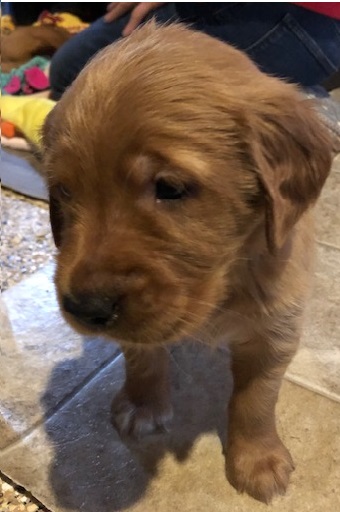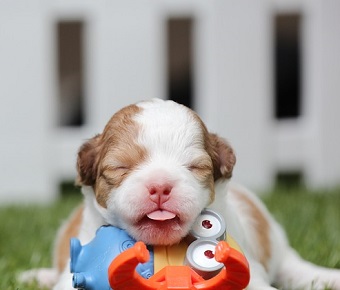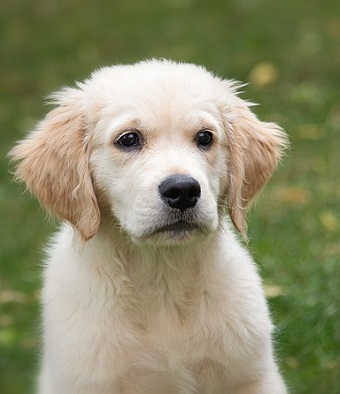When you first start training a puppy, it never seems to be as easy as what you might have seen on a YouTube video.

This is the new guy that is moving in my house in a few weeks.
I am here to help. It has been a few years since I trained my last puppies, but with a new one coming into the house in a few weeks, I have started refocusing on how to easily train a new puppy.
This time my son will be sharing in the responsibility, so I have been preplanning to make sure it goes smoothly.
I will provide you with 7 simple steps to follow for the best way to train a puppy.
Trust me, they will be simple, I need to have my 11 year old follow them as well, and we want a well-trained puppy.
I am going to give you steps to train your puppy that will make it less stressful and more productive.
Table of Contents
Keep Training Sessions Short
Not much different from children, puppies become bored easily.
Long training sessions will not produce better results and may only lead to you and your puppy getting frustrated.
Keep your training sessions only 5 to 10 minutes long at most. It is better to train several times a day than to try and train for 30 or 60 minutes at once.
A few short training sessions throughout the day will produce better results than one long training.
Eliminate Distractions
Puppies can get easily distracted. It is best to do the training one-on-one. An audience or additional family members around during training can be distracting for the puppy when you are first starting out.
Find a calm, quite area for training your puppy in your home or outdoors.
More than 1 person can do training sessions with your new puppy, but start with only 1 person present at the training session.
Pay Attention To Your Puppy’s Signals
If your puppy is feeling tired, hungry or is hot, it will be hard for them to concentrate on their training.
When they seem tired or quickly lose interest in training, it is better to postpone the training for a later time. They are more likely to retain their training when they are well rested and aren’t hungry.

This guy is too tired for training.
On the same note, don’t do a training session if you are feeling tired, hungry, irritable or impatient. If you are not in the right mood and find yourself becoming impatient, you can derail the entire training process.
The training process should be fun for both you and your puppy. Come back to the training when both of you are in the right frame of mind.
Put Yourself In Your Puppy’s Paws
Puppies don’t innately understand English (or whatever your native language is) the moment they are born. After a few weeks or months they will begin to associate words and gestures with certain actions.
If you pick up your dog’s leash and say “out”, they will learn to associate “out” as meaning that they are going outside for playtime or a walk.
Imagine that you moved to a foreign country where you didn’t speak the language. At first, you would be able to understand easier from actions that you see, and you would learn the words that are associated with that action the more it happens. This is the same for your puppy.
Your puppy may already recognize a variety of words, but the words you use for training may be unfamiliar to them. It will take some time for them to understand what you mean when you say “rollover” or “sit-stay”.
Some puppies may understand what you mean in as few as 3 or 4 training sessions, and it might take some more practice to understand what you mean.
Offer Special Tasty Treats

Avoid distractions when training a puppy.
Just like people, dogs like getting rewarded for a job well done. Offering your dog a special treat when training, will be the best way to keep their attention and wanting to do more.
You probably are giving your dog treats throughout the day, but I recommend saving special treats that are used just for training. It will help hold their interest and keep them excited to learn more.
Treats are an excellent way to reinforce positive behavior. When your dog does what you ask, be ready to immediately give them a special treat and follow that up with plenty of praise.
You will eventually remove the treats, but continue with praising them.
Offering a variety of treats will help keep them motivated to learn new tricks and commands.
The treats that I have found to work very well are Charlee Bear dog treats. They come in a variety of flavors, including grain free and they have only 2 calories each, so you can give plenty of treats and not worry you are overdoing it.
Teach These Commands First
Before your dog can be showing off a bunch of tricks to his YouTube followers, he has to learn the basic commands.
The first 2 commands you should start with are “sit” and “no”. “Sit” is a basic command that provides the foundation for most of your other commands and tricks. “No” is also needed right away for the obvious reason of keeping them out of trouble.
Teaching the “sit” command isn’t difficult. Hold a treat in your hand slightly over your dog’s head while using the “sit” command. As your dog looks up, they might naturally sit down. If they don’t, gently push their butt down and then give them the treat and praise.
Repeat this process several times a day.
After your puppy learns the “sit” command, start working on the other necessary commands. I would consider these to be the following:
- No
- Stay
- Down
- Come
- Off
- Leave It
- Heel – This one isn’t as important to all dog owners. I do not use this command.
I do have a training book that I highly recommend that could give you more guidance with your training. It is by Brandon McMillan, the star of “Lucky Dog.” If you have never seen “Lucky Dog”, I recommend to any dog lover of any age. The show is on Saturday mornings on CBS.
Brandon adopts dogs from shelters and trains them to be service dogs for people with different needs. The show is inspiring, and Brandon uses positive reinforcement to perform miracles.
His book titled “Lucky Dog Lessons – Train Your Dog In 7 Days” is a great resource, easy to read and includes some humor with examples and tips for dogs of all breeds, ages and temperament. I don’t think you will be disappointed with this read.
Use Consistent Commands
If there is going to be more than 1 person training your puppy, make sure that everyone is using the same commands for the same action. When your dog jumps up on someone, one command shouldn’t be “down” and the other command be “off”.
You can use whichever command you like, but you should be consistent using the same command and anyone else training your dog should be using the same command.
Summary
The best way to train a puppy, is with patience and consistency. When you are patient with your training, your dog will want to please you and being consistent will help them understand what is expected of them.
These 7 simple steps to follow for training a puppy should be easy for all ages and dog training abilities. Not everyone has special dog training skills, but I do feel that it is possible for all to be able to train their own dog.
The bond that you create when training your own dog is so much greater than the bond you will have with them if you let someone else train your puppy.
Give it a try, and let me know how it goes for you.
If you are still in the planning stage for bringing home a new puppy, check out how to prepare for a new puppy. This includes a checklist of needs items for your new puppy.
If you have any questions or comments, please leave them below and I will get back with you. You can follow justforyourdog.com on Pinterest or FaceBook for all the latest doggy updates.
Some of the links within this post are affiliate links of which I might receive a small compensation from sales of certain items.

